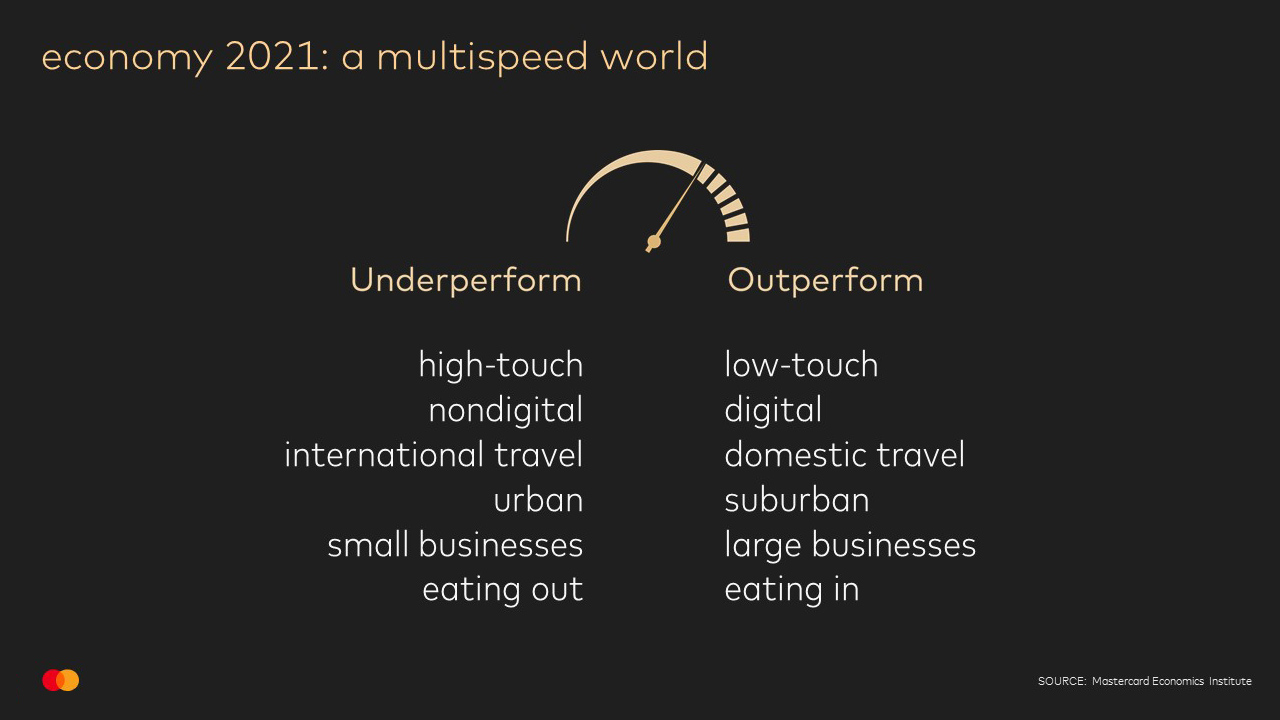
Economic Outlook 2021: The ‘E-Conomy’ is here to stay
December 6, 2020 | By Bricklin DwyerNo matter where we are, we can all agree that the world has changed — we’ve become more distanced, digital and domestically focused. Next year won’t bring a light-switch return to what life was like before COVID-19. Perhaps it shouldn’t. The acceleration of key trends, such as the shift to digital, will continue to define our lives in 2021.
Today we released the Mastercard Economics Institute’s Economy 2021, an outlook of what’s to come. The institute was launched this year to analyze the most critical trends around the globe through the lens of the consumer. Building on Mastercard’s Recovery Insights series, we created this report to help governments and businesses of all sizes find a path forward following a grueling — and transformative — 2020 in just about every economy worldwide.

With a team of data scientists and economists, we assessed key economic indicators, paired with an analysis of anonymized and aggregated sales activity across the global Mastercard network, and uncovered several critical trends:
01
The 'E-Conomy' is here to stay
In 2020, consumers and businesses turned online with urgency, and we estimate that, globally, 20-30% of the peak in the COVID-related shift to e-commerce will stick around permanently. In the U.S., this was equivalent to a two-year acceleration in the shift to e-commerce. From contactless payments and pick-up to tele-everything, digital adoption was multi-generational (meaning that grandma and grandpa are savvy online shoppers now too).
02
Welcome to digital Main Street
As many local restaurants and shops closed, 74% of new retail business created in the U.S. since April were not brick-and-mortar retailers, according to our analysis of data from the U.S. Census. We believe this trend will continue, with more and more businesses opting for virtual storefronts to reach more customers while minimizing costs.
03
Home is where the spending is
Kitchen tables became classrooms and bedrooms turned into home offices as shutdowns led people to spend more time — and money — at home. In 2021, people are expected to continue to invest in their homes, with sectors such as home furnishings and hardware reaping the benefits everywhere from Brazil to Australia and from the U.S. to the U.K. Additionally, in many Western countries consumers have shifted living and working away from central business districts, which will have a lasting effect on cities. In the U.K., for example, we have seen house prices hit a four-year high outside of London.
04
Grounded international travel brings domestic resurgence
For economies and sectors dependent on travel, the pandemic has been particularly hard-hitting. However, as travel disruptions persist, we’re seeing an emerging benefit to markets that typically have a tourism deficit (more travelers go out than in), such as China, the U.K. and Singapore. For China, 1.7% of GDP is typically spent on tourism in other countries; bringing that travel spending back home stands to lift economic growth substantially.
05
Uneven recovery
The pandemic has created a multi-speed global recovery that favors high-income consumers over low and has created a significant job divide for minorities, women and younger workers. Among the 38 countries in the Organisation for Economic Co-operation and Development, employment is down 6.3% for women and 5.2% for men overall; 24 countries have seen a bigger decline in employment for females. Meanwhile, rising prices for housing and stocks have exacerbated income disparities. Government and central-bank stimulus policies that steered economies away from worst-case scenarios are ending, but targeted intervention will likely be necessary to aid those hardest hit.
06
Government debt grows, while consumers save more
The 2020 fiscal stimulus programs dwarfed those from the 2008 financial crisis, with the U.S. Federal Reserve’s balance sheet growing as much in six months as over the prior 12 years. Even emerging markets jumped on board the bandwagon to inject money into their struggling economies. In the meantime, we’re seeing consumers shift into saving mode, carrying less debt than they have in years past.
This year has put us all to the test. We made a dramatic digital leap forward. We have seen incredible resilience from small business owners, consumers and policymakers looking to keep us on course. We have also seen an increase in social unrest around the world, often tied to local unemployment. Risks —from COVID lockdowns to climate change — put social inequities in stark focus.
With a vaccine in sight, we will be able to rebuild the connections lost this past year and forge a more resilient future — one that allows for inclusive, sustainable growth that benefits all individuals and businesses alike.
